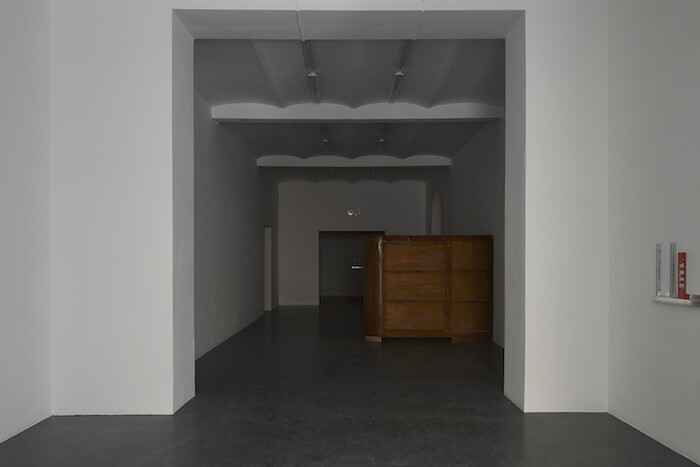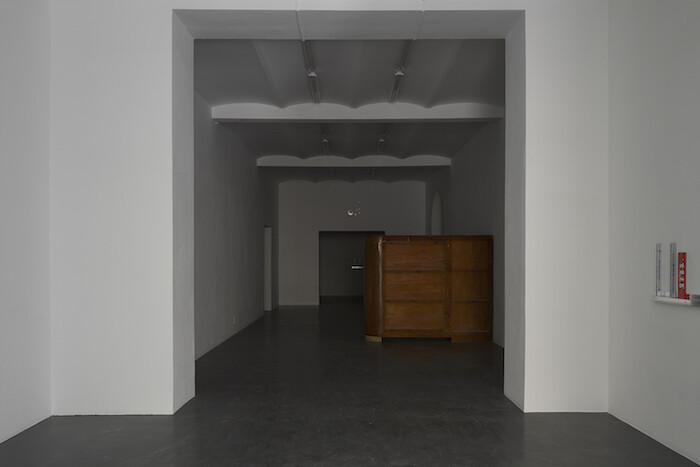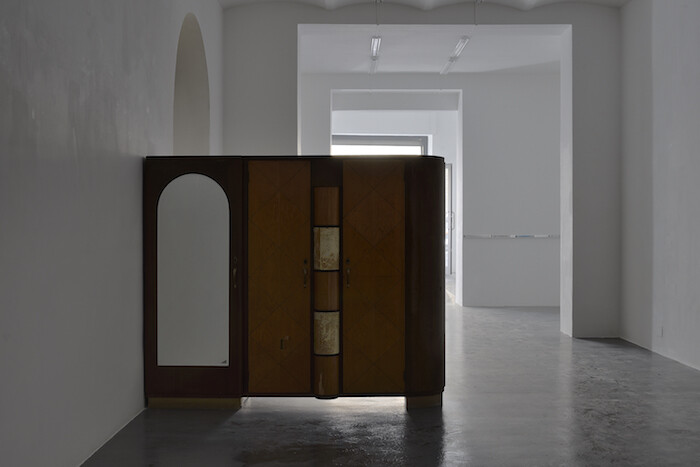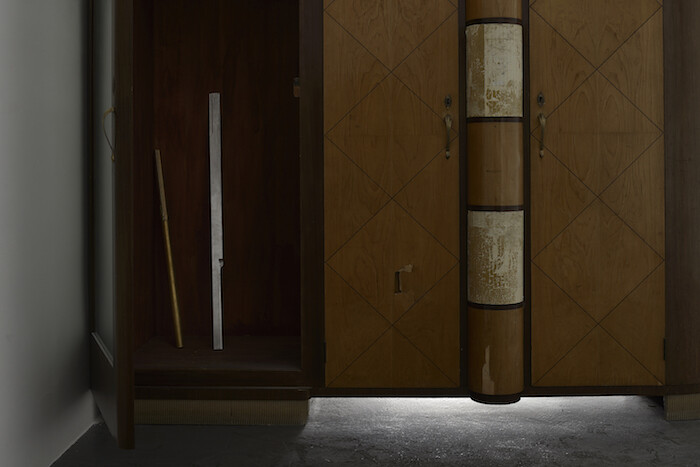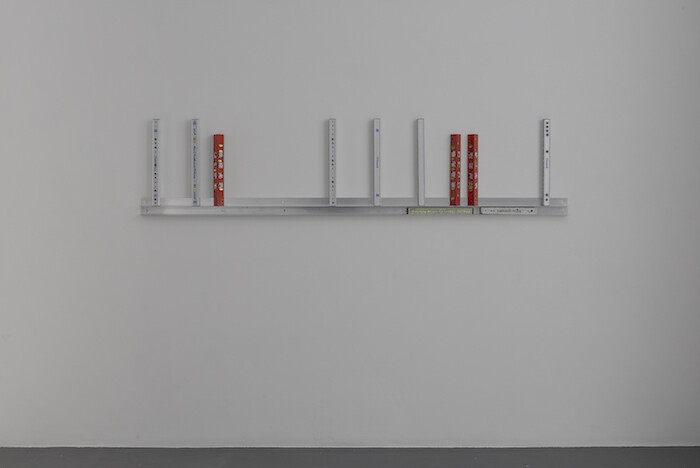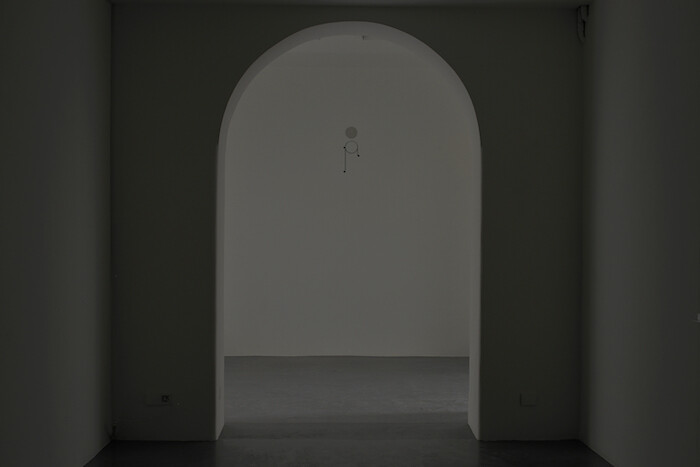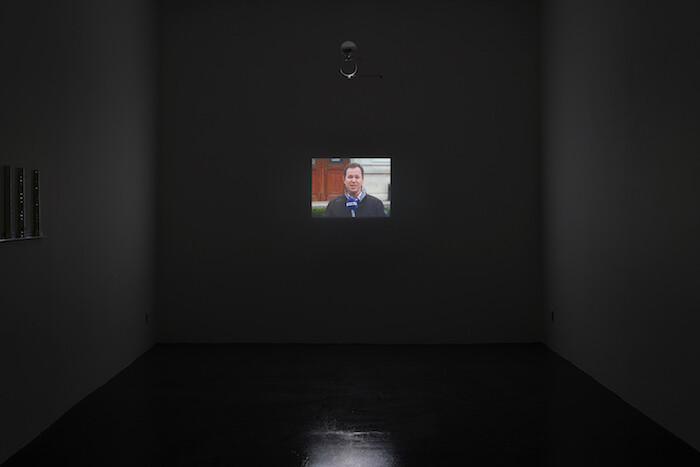“Can you see anything?” Lord Carnarvon anxiously asked Howard Carter, who was peering, through a small hole by the light of a candle, into the anteroom of the tomb of Tutankhamun. “Yes, wonderful things!” was his famous answer. Viewers who access Nick Bastis’s exhibition do not see “wonderful things”; on the contrary, because of the contrast between the dazzling Roman summer light and the semi-darkness of the gallery, for the first few seconds we see almost nothing. Nevertheless we have, like the great English archeologist, the impression of being on the threshold of a recently excavated burial space. There is no neon or halogen lamp, only daylight from the entrance door and from an arched window, normally covered, which has been opened for the occasion. A few meters from the entrance the light is already dim, and darkness reigns at the furthest end of the gallery.
At first sight, the only presence in the whole vast space is an old wardrobe. Inside it we discover two cylindrical metal objects that the artist calls “flutes” (Flutes with Armoire, 2017) and two small round shapes that materialize the volume drawn by a key turning in a lock (909, 2017). Which doors are opened by these dysfunctional keys? To which ultra-mundane dwellings does this place give access? And those mute flutes, do they serve to appease the gods of the underworld? It’s clear that sound—or rather its evocation—plays a fundamental role in the physical and conceptual architecture of this place. Along the walls, in four different locations, short plastic and metal segments, red and gray, are arranged horizontally or vertically according to a precise rhythmic pattern (Grocery dividers and sound emitters, 2016-17). From the caption, we find out that they contain rice and glass beads. We can imagine that, if agitated, they’d generate some sort of buzz. Who, or what, are they meant to call? (or, alternatively, keep at a distance?)
Following such speculations, we feel less like Carter and more like the protagonist of David Macauley’s graphic novel Motel of the Mysteries (1979): an archeologist in the future unearths a 1970s American motel, believing it to be a dynastic tomb, and interprets objects—from a telephone to a toilet brush—accordingly, leading to a chain of hilarious misunderstandings. In fact, the archeologist here is Nick Bastis, whose formal strategies charge trivial objects with an esoteric aura. Yet Bastis does not dig into the near past nor fetishize the conceptual and material tools of archeology, as per Dieter Roelstraete’s observations on the “archaeological imagery” of much recent art.1 His is instead a fictitious, prospective archeology: it evokes a future in which the traces of our present have become the remnants of a remote civilization. This is also what happens in the exhibition’s Holy of Holies, the room at the end of the gallery. There a video projection shows, at a slow and meditative pace, apparently random fragments of films, documentaries, and old television programs (Seconds, 2017), and a long silent sequence that seems to be built out of the scraps of a political history program (The non-attached, 2017). As in the main environment, we have the impression of facing relics—the fragments of an individual or collective past—the intrinsic banality of which do not diminish the whole.
In a text written on the occasion of the exhibition, the artist claims to be interested not in deciphering a given meaning, but in its creation by the spectator. In this sense, rather than by some vague formal similarities, it is legitimate to compare this exhibition to the work of an artist like Trisha Donnelly. Donnelly’s formal scarcity and silence impose a radical distance between the spectator and her works; a distance where both the excitement of a discovery, and the frustration of searching for a meaning that is always elusive, co-exist. Less drastic than Donnelly, Bastis grants the viewer a greater opening-up, the possibility of a nearly narrative path (such as that proposed here, albeit with a high degree of speculative freedom). But this does not mean we should lower our guard: in the “foreword” e-mail sent as an invitation to the exhibition,2 the artist warned viewers that “groups of works consist of the audible and the visible, and also of the inaudible and of the invisible, or, the gaps that these properties rest in … These gaps can be seen, heard and touched, which is in some way friendly but also feels like the proximity that Sun Tzu, Machiavelli, Kabir, and Pacino advise you to have to your enemy.”
Dieter Roelstraete, “The Way of The Shovel: On the Archeological Imaginary in Art,” e-flux Journal no. 4 (March 2009), https://www.e-flux.com/journal/04/68582/the-way-of-the-shovel-on-the-archeological-imaginary-in-art/.
“Press release for Nick Bastis’s ‘Sentries’,” https://www.artforum.com/uploads/guide.004/id08290/press_release.pdf.
